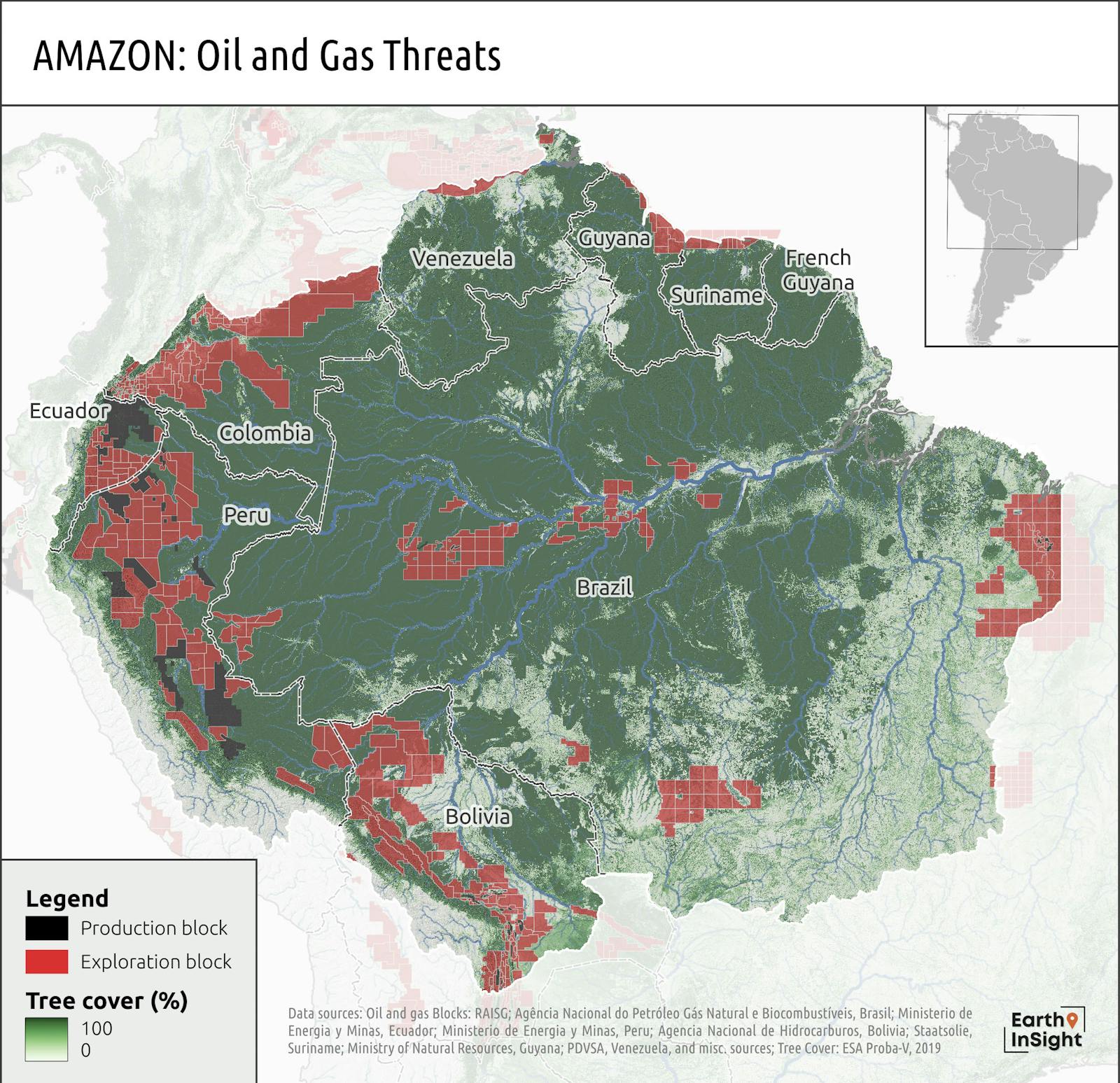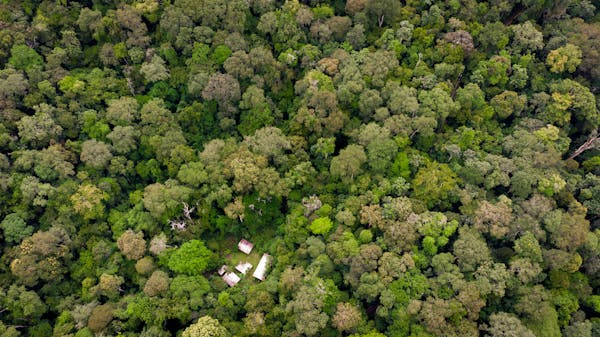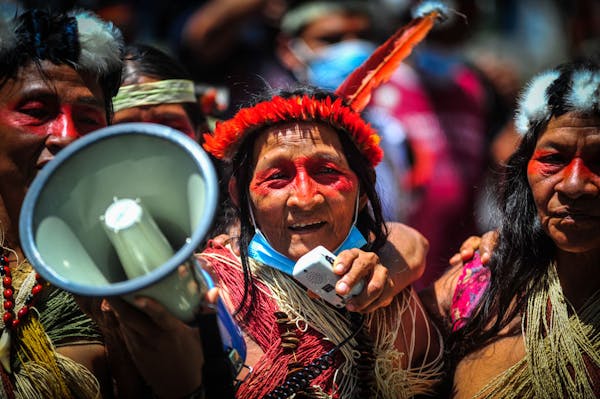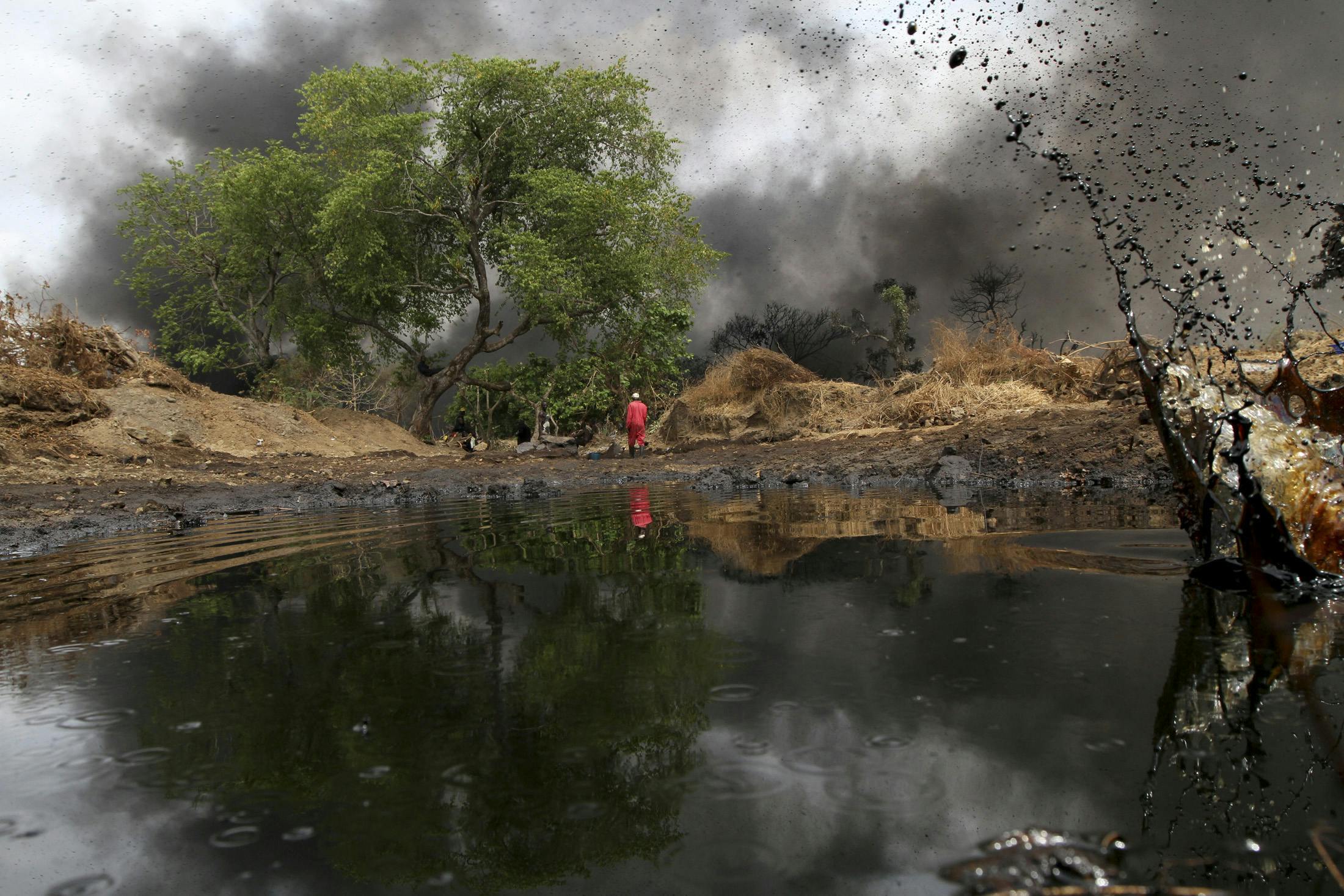
A Global Crisis Point: Oil and Gas Expansion in Critical Ecosystems
With the release of the 2023 Banking on Climate Chaos report, the world continues to get a close-up look at how many of the major financial institutions are driving the climate crisis through continued financing and investment for oil and gas expansion worldwide. Earth InSight is proud to have collaborated with and supported this critical publication by developing maps and analyzing the threat of natural gas expansion in the US Gulf South and the Verde Island passage in the Philippines. It is important to note that for the first time, this important report is now focusing on the banks involved in financing the oil and gas industry in the Amazon basin as tracked by Stand Research Group and in collaboration with Amazon Watch.
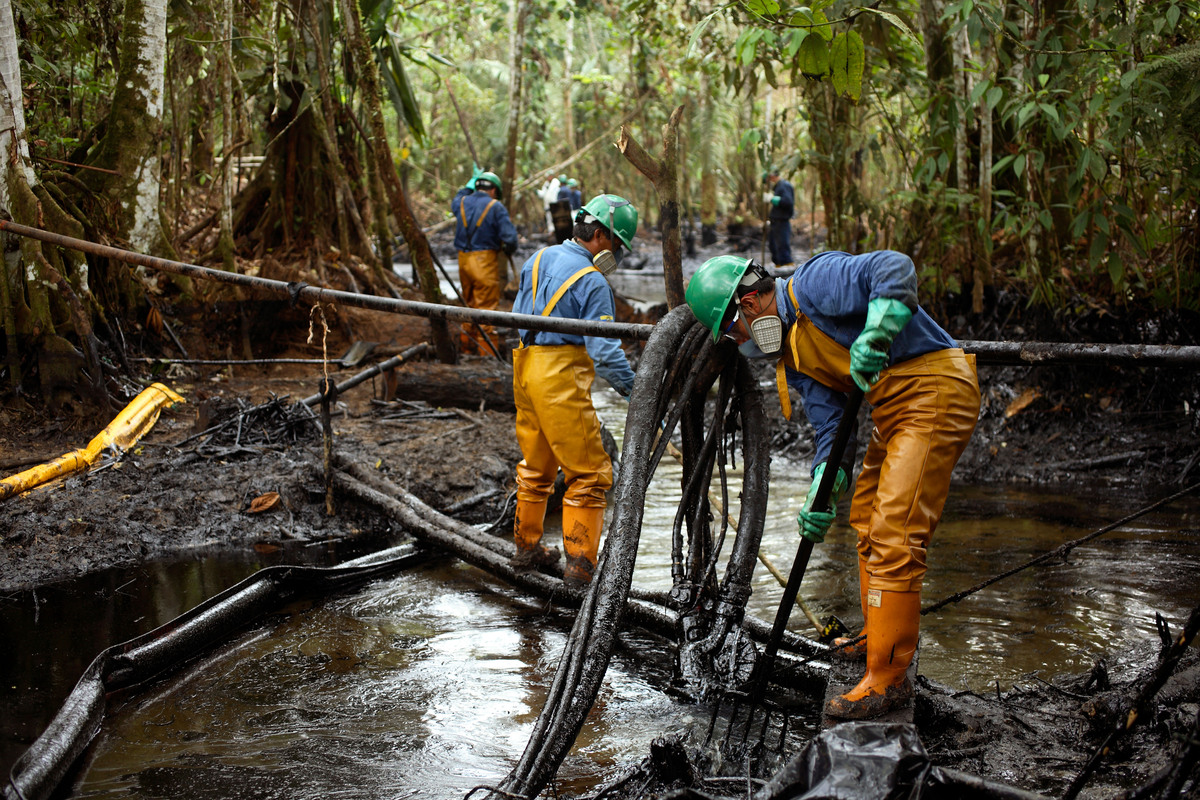
The Two Largest Rainforests in the World — In the Crosshairs of Oil and Gas Expansion
Forest ecosystems are essential for climate stability, and also vital for Indigenous and local community survival and the maintenance of biodiversity. Unfortunately, the threat of oil and gas expansion in the Amazon and the Congo basins, the two largest rainforests in the world, is immense and the world’s financial institutions are critical players that can continue to be complicit in enabling this terrible trajectory or they can establish policies that will restrict the ease and access to capital used to open up these critical rainforests for oil and gas and other extractive industries.
Earth Insight is dedicated to advancing research and building tools that help to daylight the threat of oil and gas and other industrial expansion in critical ecosystems while uplifting solutions and calls to action from Indigenous organizations and allied organizations. In our recent Crisis Point report released at a UN press conference at COP 15 in Montreal with Indigenous and regional leaders, a stark reality is evident — oil and gas expansion in the Amazon and Congo Basins is a rapidly accelerating existential threat to global climate stability and biodiversity, and to tens of millions of Indigenous People and local communities who live inside areas in operation or slated for oil and gas exploration and development.

UN COP 15 press conference with Indigenous and regional leaders from the Amazon and Congo Basin.
No Fossil Fuel Expansion. Priority Forests and Ecosystems Must Top the No-Go List.
Despite their critical importance for the future of humanity, preserving primary and priority forests¹ and ecosystems has not yet risen to be a global priority. In fact, vast sums of public and private money are being used for logging, agri-business, mining, and oil and gas drilling in these regions — causing harm to Indigenous peoples and local communities and destroying the integrity of these increasingly rare and vitally important places on the planet.
Key Findings: What’s at Stake
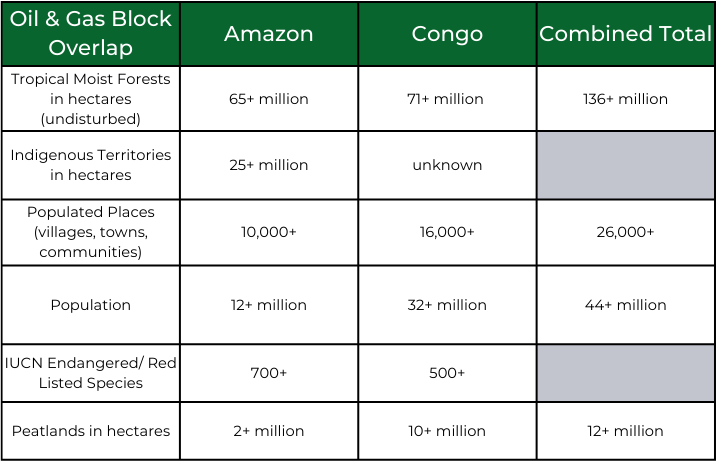
Amazonia: A Global Wonder in the Midst of a Tipping Point Crisis
Amazonia is a true bio-cultural gem and is the largest rainforest in the world — spanning nine countries and home to 2–4 million Indigenous People from 500 over distinct nationalities, it also contains the world’s richest concentrations of biodiversity. Amazonia is also in the midst of a tipping point crisis that threatens the rainforests’ very existence, and it is imperative that 80% of the forests and ecosystem be protected with an end to oil and gas and other industrial expansion.
Key findings from the Crisis Point analysis show that 25+ million hectares of Indigenous Territories, 65+ million hectares of undisturbed tropical forest, and more than 700 IUCN Endangered/Red Listed species, and more than 20% of populated places (towns, villages, etc.) now overlap with oil and gas blocks in the Amazon basin.
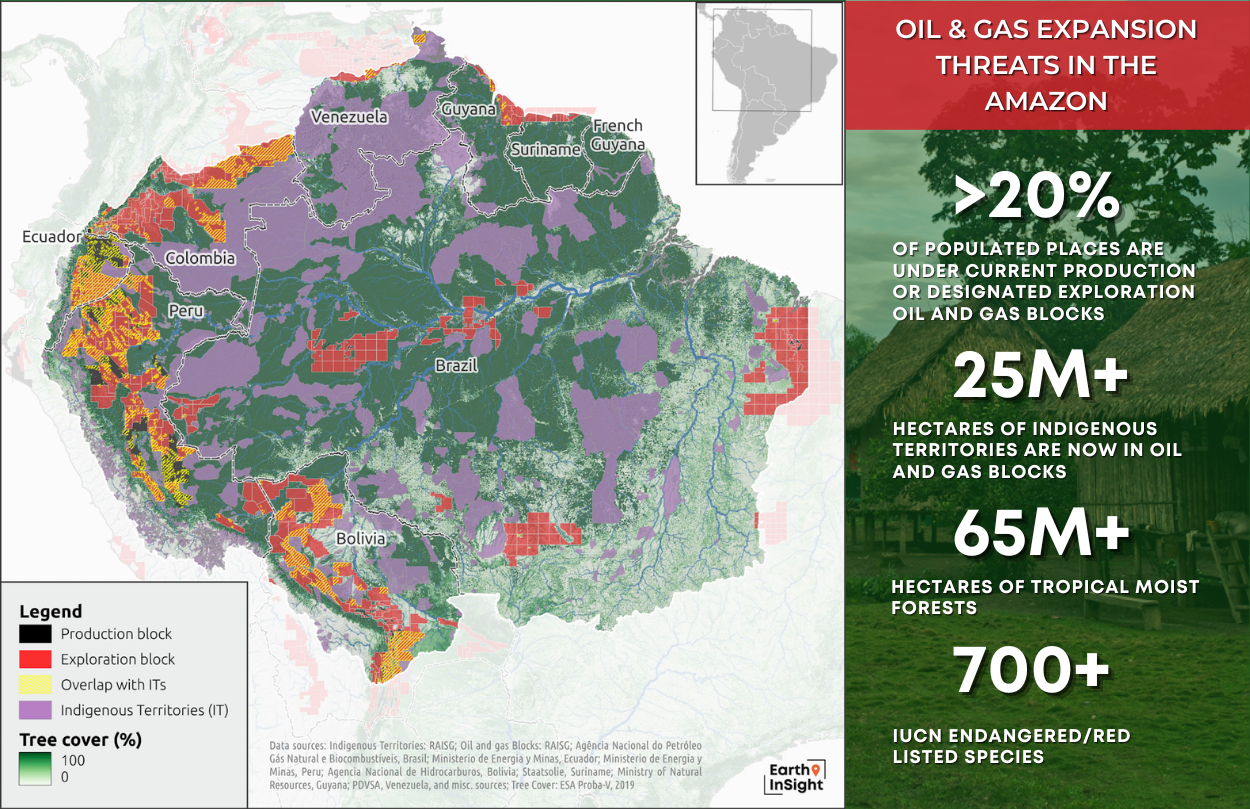
Agribusiness, mining, oil and gas extraction, and logging have been an engine of deforestation and high degradation which now stretch across 26% of the Amazon region². Scientific evidence and modeling establishes that a hydrological and ecological tipping point in the Amazon would occur when deforestation and degradation exceeds 20 to 25%³. This is the point at which deforestation and global warming trigger an irreversible cascade that would trigger feedback loops that affect the remaining rainforest. There is evidence that the Amazon is on the verge of, or already in the early stages of such collapse⁴.
Oil “Development” in the Western Amazon: A Cautionary Tale
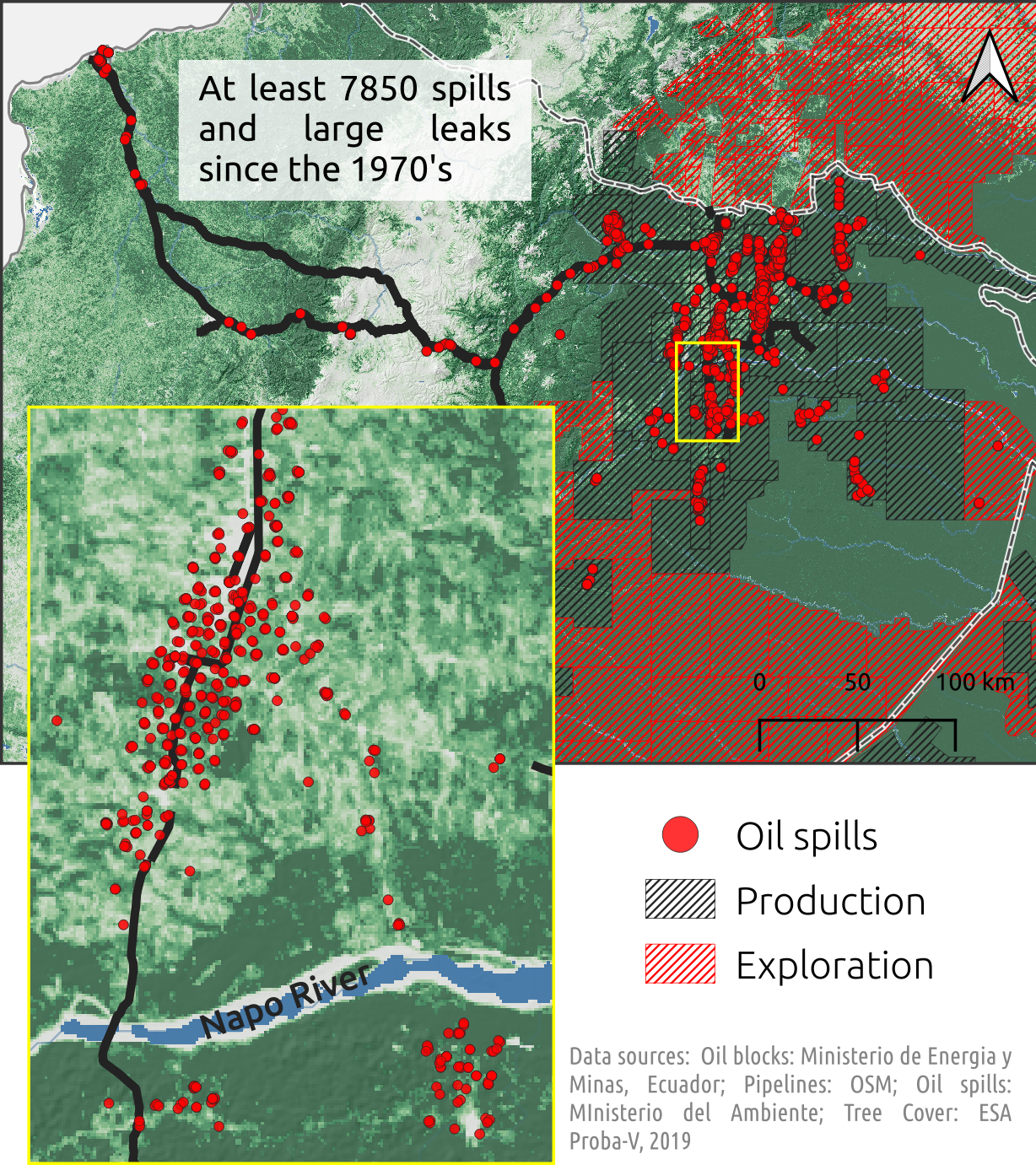
The history of oil-related contamination in the Western Amazon spans decades. Fossil fuel extraction has brought with it toxic waste and crude oil spilled from extensive and poorly-maintained pipelines. Oil development has also been associated with exposure to heavy metals and contaminants and cancer rates as high as four times that of reference populations⁵. Major pipeline ruptures in 2022⁶ and 2020 have heavily impacted the water resources of the Indigenous and local communities who live within the impact zone of the oil and gas industry. Since 1972 at least 7,850 spill sites have been inventoried by the Ministry of Environment of Ecuador. At the same time, the aging Norperuano pipeline in the Peruvian Amazon continues to spill regularly; it is estimated more than 450 oil spills have occurred in the Peruvian Amazon since 2000.⁷
Indigenous resistance has been a steady force to oil expansion and other forms of extractivism with a steady arc of victories keeping oil, mining, and other extractive interests out of their territories and customary lands⁸. As Indigenous Federations and a range of civil society organizations have been calling attention to, millions of hectares of rainforest in the Western Amazon are now under imminent threat due to oil and gas expansion. With 90% of Amazonian oil exports coming out of Ecuador, this region is a critical hotspot and a microcosm of the dangers of a path that most often leads to debt, pollution, corruption, Indigenous rights violations, and civil unrest. In order to pay off debt and meet economic demand by exporting oil to refineries in California — where half of all Amazon crude oil ends up⁹ — the Ecuadorian government is hoping to double oil production; putting millions of hectares of primarily roadless, intact rainforest at risk.
The Congo Basin contains 90% of Africa’s undisturbed tropical forests that overlap with oil and gas blocks making the region the epicenter of oil and gas expansion threats to undisturbed tropical forests on the continent, and likely the world.
Oil and gas expansion in the Congo Basin threatens to further fragment intact lands and exacerbate forest and wetland degradation and deforestation in the region. Over 180 million hectares of undisturbed tropical forests remain in the region and over 35% of these forests, or 64 million hectares (an area nearly twice the size of Germany), now overlap with over 150 production or designated exploration oil and gas blocks. It is also estimated that in the Congo Basin countries, there are over 81,000 populated places — as identified in the map below. These places are comprised of cities, towns, and villages and our analysis shows that 20% or over 16,000 populated places — representing nearly 36 million people — overlap with oil and gas blocks in the region.
In addition to the immediate threats to forests and the climate, the indirect and cumulative impacts in terms of the required roads, drilling equipment, pipelines, rigs, processing plants and use of local water sources are still higher. This infrastructure would in turn open up previously intact forest areas to a ‘cascade’ of deforestation as loggers, settlers and poachers move in.¹⁰

The Destructive Precedent of Fossil Fuel Development in Africa
Oil development is often heralded as a solution to development needs. However, the reality is that the majority of the wealth lands in the hands of fossil fuel companies, banks and other vested or corrupt interests. A closer examination of the toxic legacy of oil development in the DRC and Nigeria are a cautionary tale…
Oil in Nigeria: 50 Years of Pollution and Disastrous Community Health and Livelihood Impacts
Southern Nigeria, home of the Niger Delta, is one of the most polluted places on Earth and over 50 years of oil operations have had disastrous effects on local communities’ health and livelihoods. In fact, According to the Bayelsa State Oil and Environmental Commission, over the last half century, as many as ten million barrels of oil have been spilled across the country. That’s equivalent to a spill similar in size to the Exxon Valdez catastrophe — which devastated the coast of Alaska — every single year for the last fifty years. The health of hundreds of thousands of people has been affected by the contamination of the water they drink, the land they grow food on and the air they breathe. Estimates suggest that the pollution could be responsible for as many as 16,000 infant deaths in one year alone.
The widespread oil pollution in Bayelsa has been devastating. Research has found that people living near polluted sites have been continually exposed to elevated levels of heavy metals such as chromium, lead and mercury in their bloodstream, leading to increased risk of diseases ranging from Alzheimer’s and Parkinson’s to cancer, diabetes and kidney damage. With nearly 75% of the local population depending on fishing and farming, the Commission has come across case after case where individuals and communities have lost their livelihoods and, in some cases, reduced to destitution as the result of oil spills — underscoring the fact that the presence of oil is not a benefit to local communities, but rather it is an ongoing threat to their health, livelihoods, and very existence.

Source: Quantifying the exposure of humans and the environment to oil pollution in the Niger Delta using advanced geostatistical techniques. Christopher B. Obida, Environment international 2018
Oil in the DRC: An Ominous Warning
As reported by Human Rights Watch, production in DRC’s only exploited oil block, managed by the Anglo-French company Perenco on the country’s Atlantic coast, has been a source of ongoing health and environmental impacts. In fact, within the last decade, a Congolese Senate commission accused the government of “irresponsibility” for failing to address the air, water, and land pollution from oil operations and related leaks, flaring, and contamination in connection with oil operations. This ongoing toxic legacy in relation to oil development in Muanda and the surrounding region was also recently extensively documented by Congolese NGOs and is a point of reference of the risks associated with further oil expansion in the Congo Basin. These risks are further amplified given that many of the oil blocks slated for development in DRC are in far more remote, logistically challenging and ecologically sensitive areas.
Solutions
There are viable solutions and reference points in both the Amazon and the Congo regions that can enable humanity to chart a different path including:
- A moratorium on all industrial activity in primary and priority forests until 2050 in order to safeguard critical ecosystems and while allowing time and space to develop appropriate plans and financing including redirecting subsidies for extractive industries to support primary forest preservation and indigenous co-management, and the expansion of rights and territories
- Expansion of global Indigenous land tenure, access and resource rights, direct funding for co-management, and the requirement of Free, Prior, and Informed Consent (FPIC)
- The Amazonia for Life: 80% by 2025 Declaration from Indigenous federations across the Amazon calling for expanding indigenous rights, territories and funding, conditioned debt forgiveness, clean financing and supply chains, ending extractive activities in primary and priority forests, restoration, new financial mechanisms that preserve forests and lands, and a range of other solutions
- New debt for Climate and Biodiversity commitments from International Financial Institutions such as the IMF, large debt-holding nations like China, and other debt holders in the private sector
- With strengthened ambition related to primary forest degradation , and accelerated timelines for action, the Glasgow Leaders’ Declaration on Forests and Land Use can be a reference point
- New frameworks for financing bold climate and biodiversity action including the 10-Point Plan for Financing Biodiversity
- Commitments from banks and financial institutions to stop financing oil and gas expansion — starting with critical forest basins and ecosystems, e.g., through platforms like Exit Amazon Oil and Gas
- Increased country-level commitments to the principles of the Beyond Oil and Gas Alliance
- Widespread commitments to the Fossil Fuel Non-Proliferation Treaty
- Unlocking the vast potential in renewables and scaling up direct support to forest communities and other frontline forest defenders.
Prioritizing and financing primary forest and ecosystem protection is an investment in the future of humanity that will yield dividends for generations to come.
[1] Primary Forest Alliance Definition: https://primaryforest.org/wp-content/uploads/2022/11/Primary-Forest-Alliance-Moratorium-Call-2.pdf page 6) Accessed November 2022 and see full definition in appendix
[2] Amazonia Against the Clock 2022: Amazonia for Life Coalition. Accessed at: https://amazonia80x2025.earth/amazonia-against-the-clock/
[3] Amazon Tipping Point, Science Advances 2018 Nobre and Lovejoy: Accessed at: https://www.researchgate.net/publication/323341184_Amazon_Tipping_Point
[4] Flores, B.M., Holmgren, M. White-Sand Savannas Expand at the Core of the Amazon After Forest Wildfires. Ecosystems 24, 1624–1637 (2021). https://doi.org/10.1007/s10021-021-00607-x: https://link.springer.com/article/10.1007/s10021-021-00607-x#citeas
[5] “Exposures and cancer incidence near oil fields in the Amazon basin of Ecuador”, 2001. San, Armstrong, Cordoba, and Stephens: https://www.ncbi.nlm.nih.gov/pmc/articles/PMC1740173/
[6] https://www.nbcnews.com/news/world/oil-spill-sprays-crude-ecuadors-amazon-rainforest-rcna14084
[7] The New York TImes, “The Health of the People of the Amazon was in Crisis Long”, October 2, 2020. Available at: https://www.nytimes.com/2020/10/02/opinion/amazon-pollution-oil.html
[8] Amazon Watch: Indigenous Resistance Expels Oil Company GeoPark from Peruvian Amazon: https://amazonwatch.org/news/2020/0717-indigenous-resistance-expels-oil-company-geopark-from-peruvian-amazon
[9] Stand.earth and Amazon Watch (2022). Linked Fates: How California’s Oil Imports Affect the Future of the Amazon Rainforest, https://stand.earth/resources/linked-fates-how-californias-oil-imports-affect-the-future-of-the-amazon-rainforest/
[10] Roads to Ruin: The Emerging Impacts of Infrastructure Development in Congo Basin Forests. https://www.rainforestfoundationuk.org/wp-content/uploads/2021/10/infrastructure-report.pdf
Read it on Medium


